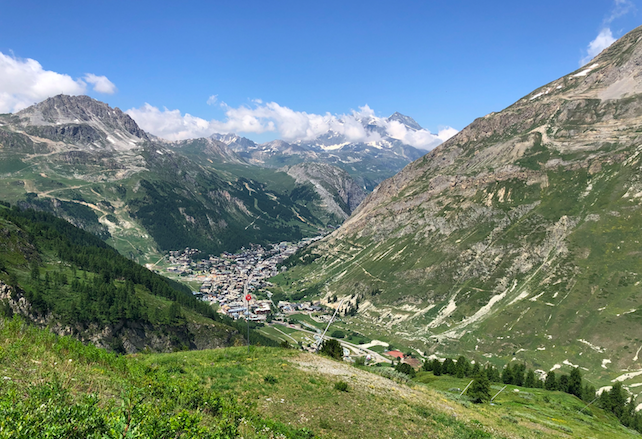
Ok, so I’m never going to be crowned King of the Mountains and get to wear that polka-dot jersey. Age, to put it mildly, along with fitness and cycling skills, are geared against me. But, thanks to 21st-century technology, I’ve just discovered that I can still climb to the ‘roof’ of the greatest two-wheeled pedal race on earth and win my own personal Tour de France.
Frankly, I’m not much of a road cyclist. I don’t know a breakaway from a bunch sprint and, until now, I believed that a domestique* was a marital ding-dong of the kind where you where you both wake up in the morning and can’t remember what it was all about.
I’ve learned the difference between bidons (water bottles) and bidets – you don’t fill one from the other. But jargon apart there’s a lot to discover about the Tour that dominates European TV screens for 23 days each July, and in 2019 there’s no better place to appreciate the character of this truly gruelling contest than in Val d’Isere.
In winter, the resort is renowned by skiers from all over the world for the extent of its challenging terrain and guaranteed snow cover. But it has a life in summer, too. The ancient village sits in steep and rural splendour on the edge of the Vanoise National Park. When the snows finally melt and the sun comes out, the flower-filled meadows attract tourists for a whole host of sporting activities. These range from summer skiing on the glacier and trout-fishing in alpine lakes, to hiking and of course biking, both on and off-road.
However, it’s the 15km winding route up the col de l’Iseran above the resort that’s the iconic attraction of all Lycra-clad Tour fans. From Val d’Isere at 1850m the tarmac snakes up to the 2770m summit before plunging again down the north side, linking the Haute Tarentaise with the neighbouring Maurienne valley. This is the highest paved road over a mountain pass in the whole of the Alps and therefore a natural contender for inclusion in the Tour.
The Alps in general and the Col de l’Iseran in particular are renowned for surprises during the Tour, but no one could have predicted the dramatic events of this year. During the penultimate stage new Colombian hero Egan Bernal made his successful bid for the yellow jersey with an epic climb, only for the day’s racing to be stopped on the summit because of a giant hailstorm that turned the road white. As if that wasn’t unusual enough in three weeks of racing in mainly Saharan temperatures, the hail was followed by a massive mud slide across the road. The 22-year-old went on to be crowned the Tour winner in Paris two days later, but he’ll never forget his dramatic conquering of the col.
The stage started gently uphill from St Jean de Maurienne, but the actual climb began 73km on in the beautiful old hamlet of Bonneval-sur-Arc. Little more than an hour later at 80kph the riders flash through Val d’Isere before climbing to the finish in neighbouring Tignes.
The difficulty lies not so much in the steepness of the col – it averages 7.3% and a maximum of 10% – but in its length at this energy-sapping altitude. On the way up, the thin air makes for spaghetti legs. From Bonneval to the top is an exhausting 13.4km rising through just under 1000 vertical metres. To put it in an urban perspective, you have to pedal up rather more than three times the height of the Shard or the Eiffel Tower.
So can a mortal like me make it to the top while staying (almost) in touch with the pace of the Lycra-clad peloton? Earlier in July I borrowed a bit of electronic wizardry to find out.
E-bikes in the UK are still at an early stage of acceptance and, to pedal purists, riding one is generally regarded as a form of cheating – a bit like using a mountain train as a lift in the Bernese Oberland during the early days of ski tourism in the Edwardian era. No pain no gain.
But elsewhere in Europe, the e-bike revolution has already gathered pace, with rentals in ski resorts a mainstay of summer business. In Austria, for example, more people own an e-bike than a second car.
Firstly, you have to bust the myth that you don’t have to pedal or change gear at all. What the battery does is simply make the going a bit easier when you need help. Of course, how much of this assistance you use is up to you. For me, e-bikes takes decades off my age. At the end of a long ride I feel happy and well exercised rather than physically drained.
I rented a Scott e-mountain bike from MattisSports in Val d’Isere (+33 4 79 06 00 72). Cost 55€ full day /42€ half day).
My companion Matt is an a serious road cyclist in peak condition and nearly 30 years my junior. Judging by the expression on his face, he views e-bikes with the suspicion bordering on disdain that I normally reserve for cold callers. Instead, he chose a carbon fibre racing bike from Pitte Sports (+33 4 79 06 00 09). Cost: 39€ full day / 22 € morning, 30€ afternoon). Matt did, in fact, later go electric and enjoyed the experience.
The duel was on, but first we had to get from Val d’Isere to our starting point 30km away on the far side of the col, because I really didn’t fancy climbing the mountain twice in one day. Ash Gerrard and his wife Helen stepped in to help. They run Snowdrone, an airport transfer company based in the resort with a fleet of 26 vehicles that includes two Teslas with bike racks. If you’re going to e-bike to the roof of the Tour, you might as well warm up in full electrical style in a Model X.
And They’re Off
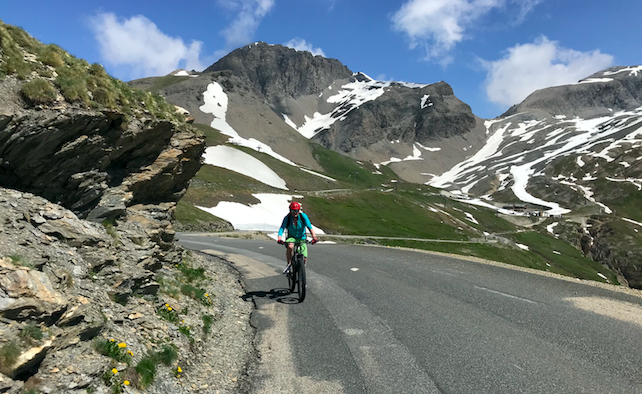
I keep telling myself and Matt that this is not a race, just a pleasant outing on two different forms of sporting two-wheeled transport. We can stop whenever we want, while we drink in the magnificent views across the peaks and flower-drenched meadows of the Vanoise. We can go as slow as we like, can’t we?
Well, yes and no. Matt explains that he has only one climbing speed and once he’s in the groove, he likes to stay there at a rhythmic 12-15kph.
Me? I have five normal speeds: No Battery (difficult uphill), Eco, Tour, Sport, and Turbo. I choose Tour, which, once I am in the right mid-range gear, sees me pedalling relatively comfortably on Matt’s back wheel as we head uphill past alpine cows grazing in startlingly verdant meadows.
The road is lined every kilometre with a marker stone. As the going gets steeper it seems that the supposed 1000m gap between them must surely be becoming progressively longer.
By the 5km mark, Matt is 200m ahead and steadily pulling away. He’s not getting faster, it’s me that is getting slower. I’m forced to raise my battery power to the Sport level and slowly wind him in again – the hare and the tortoise.
So far, I have rationed battery power as much as I can, but after 60 minutes I am now eating it up at an alarming rate. What I want to avoid is running out of juice altogether and pushing 25 kilos of bike up the final kilometres to the top of the pass.
As the air gets thinner, the effort becomes greater. It may be July, but there’s still plenty of snow by the roadside – great drifts of the stuff. On an e-bike, you don’t have to just concentrate all your energy on keeping the wheels turning. You’re free to drink in the magnificent surroundings, the murmur of mountain streams and a lone ibex standing on atop an impossibly steep crag. But you’re aware: you must be making proper progress when a load of skiers and a ski-lift on the Pisaillas glacier heave into view.
By the time we reach the final marker, I know that I have enough battery remaining to reach the quaint chapel and landmark signpost on the summit. I slip into Turbo. Pedal pain drains away and I’m back on Matt’s wheel as the ground levels out.
After admiring the views and the chapel where a priest regularly blesses bikes, the headlong descent for 15km to Val d’Isere is our reward in glorious summer sunshine – no hail or mudslides today. Matt speeds ahead on his racing bike, his thin wheels somehow keeping contact with the tarmac on the bends. I follow more sedately, but still reach speeds of up to 70kph before slowing to real-time tortoise around the hairpins with sheer drops off the sides. Familiar winter pistes – they include stretches of the road – look impossibly steep without their blanket of snow.
After so much exercise, we’re both hungry. I’m told that by the time the real riders reach this point of the Tour their digestion is shot. As their punished bodies revolt against the outer limits of endurance, they have to rely on such dubious delicacies as liquidised chicken. Matt and I can do better than that. We put on the brakes just short of Val in the farming hamlet of Le Fornet, home to chef Benoit Vidal’s Michelin two-star L’Atelier d’Edmond. This is a restaurant for special celebrations, but the sunny terrace of his adjoining bistrot is equally charming and much more modestly priced.
I’ve proved my point – the contest between hare and e-tortoise proves pretty equal. The advent of the e-bike allows people like me to sample the toughest climb of the Tour and still enjoy a superb bike ride in the company of younger and fitter ‘real’ cyclists. Off-piste Val d’Isere has 162km of trails across the bike park that it shares with Tignes and some 50km are reserved for e-bikes. It’s a great place for active family holiday in the dramatically beautiful surroundings of the Vanoise National Park. Val d’Isere normally has more than it’s fair share of warm sunshine during the summer months. This summer the thermometer has already topped a record 30C in the village at 1850m.
Fact Box
Peter Hardy stayed in Val d’Isere at three-star Maison de Famille Les 5 Freres from 132€ per room per night half-board. The building was formerly the home of one of Val’s founding families and the comfortable suites are beautifully decorated with Alpine antiques and ancient photographs. Snowdrone charges from 65€ pp for a shared transfer from Geneva airport. More information from Val d’Isere Tourism.
*A domestique is a Tour team ‘maid’ who sacrifices his own ambitions to carry out such tasks as ferrying bidons and snacks from a back-up vehicle to the team leaders.










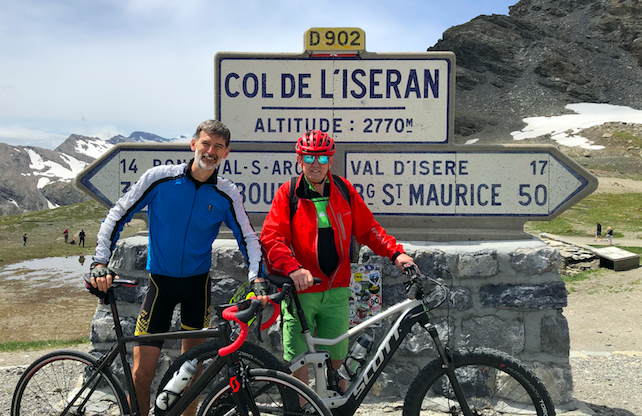
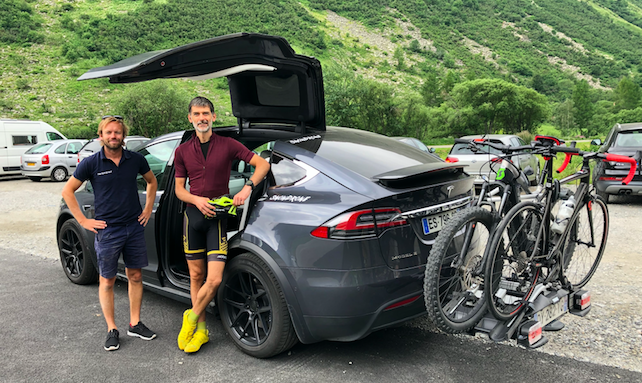
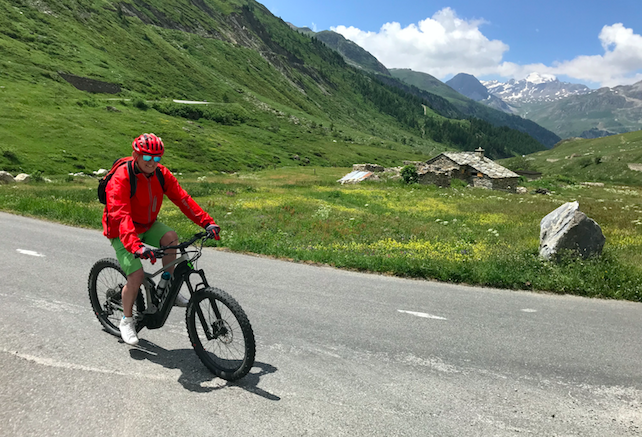
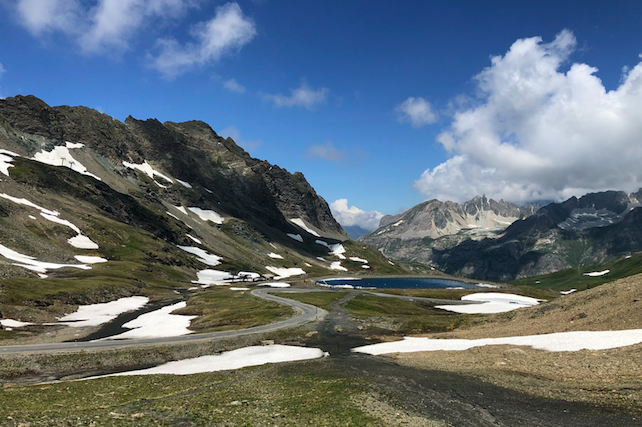
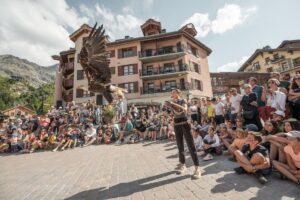
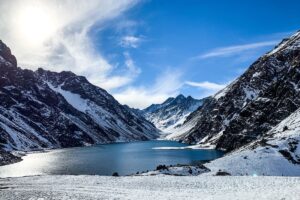
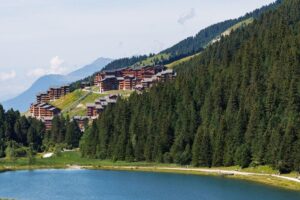
Add Comment